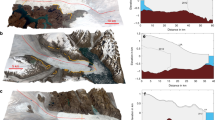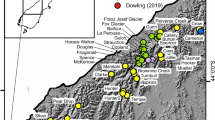Abstract
The contribution to sea-level rise from mountain glaciers and ice caps has grown over the past decades. They are expected to remain an important component of eustatic sea-level rise for at least another century1,2, despite indications of accelerated wastage of the ice sheets3,4,5. However, it is difficult to project the future contribution of these small-scale glaciers to sea-level rise on a global scale. Here, we project their volume changes due to melt in response to transient, spatially differentiated twenty-first century projections of temperature and precipitation from ten global climate models. We conduct the simulations directly on the more than 120,000 glaciers now available in the World Glacier Inventory6, and upscale the changes to 19 regions that contain all mountain glaciers and ice caps in the world (excluding the Greenland and Antarctic ice sheets). According to our multi-model mean, sea-level rise from glacier wastage by 2100 will amount to 0.124±0.037 m, with the largest contribution from glaciers in Arctic Canada, Alaska and Antarctica. Total glacier volume will be reduced by 21±6%, but some regions are projected to lose up to 75% of their present ice volume. Ice losses on such a scale may have substantial impacts on regional hydrology and water availability7.
This is a preview of subscription content, access via your institution
Access options
Subscribe to this journal
Receive 12 print issues and online access
$259.00 per year
only $21.58 per issue
Buy this article
- Purchase on Springer Link
- Instant access to full article PDF
Prices may be subject to local taxes which are calculated during checkout



Similar content being viewed by others
References
Meier, M. F. et al. Glaciers dominate eustatic sea-level rise in the 21st century. Science 317, 1064–1067 (2007).
Cogley, J. G. Geodetic and direct mass-balance measurements: Comparison and joint analysis. Ann. Glaciol. 50, 96–100 (2009).
Rignot, E. & Kanagaratnam, P. Changes in the velocity structure of the Greenland ice sheet. Science 311, 986–990 (2006).
Allison, I., Alley, R. B., Fricker, H. A., Thomas, R. H. & Warner, R. C. Ice sheet mass balance and sea level. Antarct. Sci. 21, 413–426 (2009).
Cazenave, A. et al. Sea level budget over 2003–2008: A reevaluation from GRACE space gravimetry, satellite altimetry and Argo. Glob. Planet. Change 65, 83–88 (2009).
Cogley, J. G. A more complete version of the world glacier inventory. Ann. Glaciol. 50, 32–38 (2009).
Hock, R., Jansson, P. & Braun, L. in Global Change and Mountain Regions—A State of Knowledge Overview (eds Huber, U. M., Reasoner, M. A. & Bugmann, H.) (Springer, 2005).
Lemke, P. et al. in IPCC Climate Change 2007: The Physical Science Basis (eds Solomon, S. et al.) (Cambridge Univ. Press, 2007).
Meehl, G. A. et al. in IPCC Climate Change 2007: The Physical Science Basis (eds Solomon, S. et al.) (Cambridge Univ. Press, 2007).
Raper, S. C. B. & Braithwaite, R. J. Low sea level rise projections from mountain glaciers and ice caps under global warming. Nature 439, 311–313 (2006).
Nakićenović, N. & Sward, R. (eds) Special Report on Emission Scenarios 570–599 (Cambridge Univ. Press, 2000).
Radić, V. & Hock, R. Regional and global volumes of glaciers derived from statistical upscaling of glacier inventory data. J. Geophys. Res. 115, F01010 (2010).
Dyurgerov, M. B. Glacier Mass Balance and Regime: Data of Measurements and Analysis, INSTAAR Occasional Paper No. 55 (2002).
Dyurgerov, M. B. & Meier, M. F. Glaciers and the Changing Earth System: A 2004 Snapshot. Occasional Paper 58, Institute of Arctic and Alpine Research, (Univ. Colorado, 2005).
Heaberli, W. et al. Fluctuations of Glaciers, 1995–2000, Vol. 8 (Intl. Comm. on Snow and Ice, Intl. Assoc. of Hydrol. Sci./UNESCO, 2005).
Kållberg, P. W., Simmons, A. J., Uppala, S. M. & Fuentes, M. The ERA-40 Archive. ERA-40 Project Report Series 17, (ECMWF, 2004).
Beck, C., Grieser, J. & Rudolf, B. A New Monthly Precipitation Climatology for the Global Land Areas for the Period 1951 to 2000. Climate Status Report 2004, (German Weather Service, 2005).
Bahr, D. B., Meier, M. F. & Peckham, S. D. The physical basis of glacier volume–area scaling. J. Geophys. Res. 102, 20355–20362 (1997).
Radić, V., Hock, R. & Oerlemans, J. Analysis of scaling methods in deriving future volume evolutions of valley glaciers. J. Glaciol. 54, 601–612 (2008).
Burgess, D., Sharp, M., Mair, D., Dowdeswell, J. & Benham, T. Flow dynamics and iceberg calving rates of Devon Ice Cap, Nunavut, Canada. J. Glaciol. 51, 219–230 (2005).
Dowdeswell, J. A., Benham, T. J., Strozzi, T. & Hagen, O. Iceberg calving flux and mass balance of the Austfonna ice cap on Nordaustlandet, Svalbard. J. Geophys. Res. 113, F03022 (2008).
Kaser, G., Cogley, J. G., Dyurgerov, M. B., Meier, M. F. & Ohmura, A. Mass balance of glaciers and ice caps: Consensus estimates for 1961–2004. Geophys. Res. Lett. 33, L19501 (2006).
Hock, R., de Woul, M., Radić, V. & Dyurgerov, M. Mountain glaciers and ice caps around Antarctica make a large sea-level rise contribution. Geophys. Res. Lett. 36, L07501 (2009).
Woodward, J., Sharp, M. & Arendt, A. The influence of superimposed-ice formation on the sensitivity of glacier mass balance to climate change. Ann. Glaciol. 24, 186–190 (1997).
Paterson, W. S. B. The Physics of Glaciers 3rd edn (Elsevier, 1994).
The Global Land One-kilometer Base Elevation (GLOBE) (Digital Elevation Model, Version 1.0. National Oceanic and Atmospheric Administration, National Geophysical Data Center, http://www.ngdc.noaa.gov/mgg/topo/globe.html, 1999).
Radić, V. & Hock, R. Modelling mass balance and future evolution of glaciers using ERA-40 and climate models– A sensitivity study at Storglaciären, Sweden. J. Geophys. Res. 111, F03003 (2006).
Acknowledgements
We thank A. Rasmussen, F. Anslow, A. Arendt, M. Haseloff and M. Truffer for comments on the manuscript. Mass balance data were provided by M. de Woul, M. Dyurgerov and J. Shea. The Arctic Region Supercomputing Center at the University of Alaska provided computing resources. Funding was provided by FORMAS, Sweden (project 21.4/2005-0387).
Author information
Authors and Affiliations
Contributions
V.R. led the development of this study, prepared all data sets and carried out all calculations. R.H. initiated the study and contributed to the development of the methodology, discussion of results and the writing of the manuscript.
Corresponding author
Ethics declarations
Competing interests
The authors declare no competing financial interests.
Supplementary information
Supplementary Information
Supplementary Information (PDF 622 kb)
Rights and permissions
About this article
Cite this article
Radić, V., Hock, R. Regionally differentiated contribution of mountain glaciers and ice caps to future sea-level rise. Nature Geosci 4, 91–94 (2011). https://doi.org/10.1038/ngeo1052
Received:
Accepted:
Published:
Issue Date:
DOI: https://doi.org/10.1038/ngeo1052
This article is cited by
-
Climatic and topographic controls on glacial changes (1973–2020) in Shigar Basin, Central Karakoram, Northern Pakistan
Environmental Science and Pollution Research (2023)
-
Long-term annual and seasonal mass balance reconstruction and sensitivity analysis of Chhota Shigri Glacier in Western Himalaya
Environmental Science and Pollution Research (2023)
-
Freeze-thaw cycle effects on granite and the formation mechanism of long-runout landslides: insights from the Luanshibao case study in the Tibetan Plateau, China
Bulletin of Engineering Geology and the Environment (2023)
-
Estimating thickness of Zemu glacier, Sikkim (India) using ice-flow velocity approach: a geoinformatics based perspective
Spatial Information Research (2023)
-
South Asian black carbon is threatening the water sustainability of the Asian Water Tower
Nature Communications (2022)



